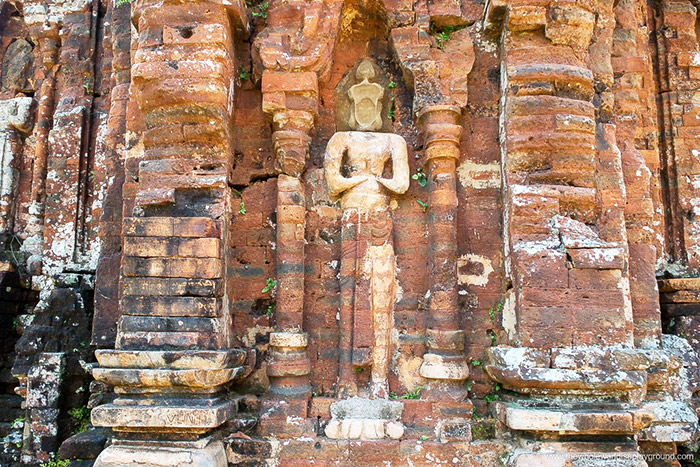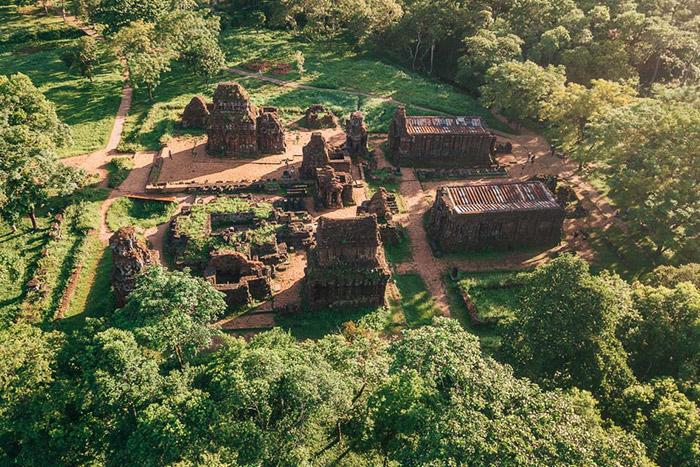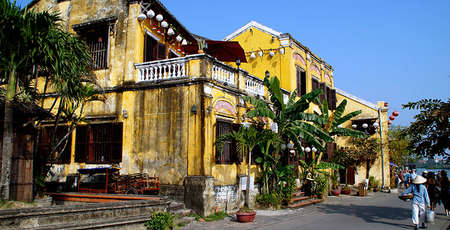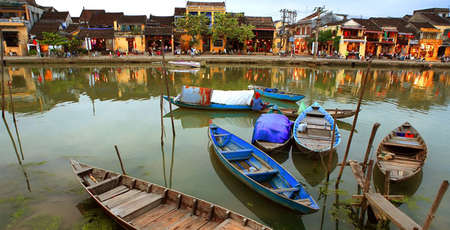
My Son Sanctuary: A treasure of the Champa kingdom around Hoi An
- on Sep 14, 2019 By: Ngoc Nguyen
Located 50 kilometers from Hoi An in a beautiful green valley surrounded by hills, the archaeological site My Son is one of the essential visits to make during your stay in the central region of Vietnam. Classified as a World Heritage Site by UNESCO, My Son sanctuary is a religious and political capital of the Champa kingdom. It is a set of Cham temples whose spiritual roots link to Hinduism. This remarkable site is often compared to other complexes of archaeological temples in Southeast Asia such as the Borobudur in Java, Indonesia, Angkor Wat in Cambodia and the Bagan in Burma.
History of My Son sanctuary
From the 4th to the 13th century, the coastline of central Vietnam was the cradle of the Cham civilization with inspiration from the Indian Hindu spiritual practices. At that time the My Son valley was a place of religious ceremony for the kings of the dominant Champa dynasties, as well as a burial place for Cham royalty and national heroes. It was in the 4th century that the sovereign Bhadravarman built a wooden temple in My Son dedicated to the worship of the lingam of the god-king Civa Bhadresvara. Unfortunately destroyed by fire in the 7th century, the King of 4th dynasty of Champa Kingdom, Sambhuvarman, rebuilt the temple in baked brick and stone pillars decorated with reliefs in sandstone depicting scenes from the Hindu mythology and consecrated it to Sambhubhadresvara. The successive Cham kings embellished the site for nearly ten centuries, evoking in a luminous way the spiritual and political life of an important stage in the history of Southeast Asia.

The My Son Sanctuary, World Heritage Site by UNESCO in 1999
The Hindu towers of My Son sanctuary are located in a well-protected site at the top of a circus which draws a kind of natural amphitheater made of several concentric hills. The location was not chosen at random; it symbolizes the grandeur and purity of Mount Meru, the mythical sacred mountain and cradle of Hindu gods in the center of the universe.
The My Son archaeological site was discovered in 1889 by the Frenchman Camille Paris who was on a cartographic mission in the region. Subsequently, Henri Parmentier carried out archaeological excavations in 1903 and 1904 for eleven months on the site of My Son. This renowned archaeologist and head of the EFEO Archaeological Service created a few years later the Cham museum in Da Nang.
Visit My Son sanctuary

The archaeological site suffered not only severe weather conditions such as floods and high humidity but also US bombing during the Vietnam War. Today we can admire the ruins of some monuments among seventy temples and ancillary buildings. The temples of My Son of different periods and styles come from two distinct eras in the Art of Champa, My Son E1 and My Son A1. My Son A1 dates from the 10th to the 11th century, a period marked by the revival of Java's influence and which corresponds to a "golden age" for Cham art and succeeds the Buddhist period of Dong Duong. As for the My Son E1 style it was the first identifiable style that was nicknamed. This style is named after a particular structure which specialists call My Son E1. The works of this style reflect the foreign influence of various sources, mainly Khmer Cambodia pre-Angkorian but also the art of Dvaravati, the Javanese art of Indonesia and southern India.

Temple My Son E1
The most famous work of My Son E1 style is perhaps a large sandstone base dating from the second half of the 7th century. Originally, the pedestal had a religious function and was used to support an immense lingam as a symbol of Siva, the main deity of the Cham religion. The pedestal itself is decorated with relief sculptures depicting scenes from the life of ascetics: ascetics playing various musical instruments, an ascetic preaching to animals and an ascetic receiving a massage. For the Cham, the pedestal symbolized Mount Kailasa, the mythological home of Siva which also housed many ascetics living in forests and caves in the same way that the lingam he supported represented the god himself.

Useful information
Every morning and early afternoon at 9:30, 10:30 and 14:30 you can watch a traditional Cham dance show.
If you are traveling independently you can take a guide on site that will explain in detail the fascinating history of this archaeological site.
Other nearby interesting places
On the way to My Son do not forget to visit the Bang An Cham Tower. After discovering the archaeological site of My Son you can make a pleasant cruise on the poetic river Thu Bon to return to the ancient streets in Hoi An. You can consider a few stops in the vicinity of Hoi An like visiting some traditional craft towns where you will discover beautiful small villages with photogenic scenery. Along the way you can admire the magnificent landscape with coconut trees perched on the rivers’ banks and the life of the fishermen. Then you can go to the water's edge of the beautiful beach of Cua Dai and the Bay Mau coconut forest in which lies Cam Thanh, a fishing village where time seems to have frozen for eternity.
Related articles:
>> The Japanese covered bridge: a timeless symbol of the Hoi An old town
>> Cooking class in Hoi An: an indispensable activity when traveling to Vietnam
>> Hoi An night markets: a must-see in the old city
>> Chaozhou Hall: A place to visit in Hoi An
>> Lantern making in Hoi An: a preserved tradition in this charming city
Comment
Other Blog
Categories
Latest News
on 31 Dec, 2025
on 31 Dec, 2025
 Español
Español Français
Français




















Morgane Ter Cock
on Dec 18, 2025HerbertPhomaMS
on Oct 19, 2025Lilyan Cuttler
on Oct 15, 2025Avenue17XC
on Sep 14, 2025Avenue18JL
on Jul 21, 2025